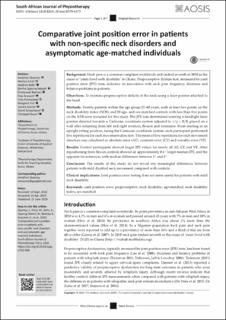Bitte benutzen Sie diese Kennung, um auf die Ressource zu verweisen:
https://doi.org/10.21256/zhaw-3155Langanzeige der Metadaten
| DC Element | Wert | Sprache |
|---|---|---|
| dc.contributor.author | Quartey, Jonathan | - |
| dc.contributor.author | Ernst, Markus | - |
| dc.contributor.author | Bello, Ajediran | - |
| dc.contributor.author | Oppong-Yeboah, Bertha | - |
| dc.contributor.author | Bonney, Emmanuel | - |
| dc.contributor.author | Acquaah, Kow | - |
| dc.contributor.author | Asomaning, Felix | - |
| dc.contributor.author | Foli, Margaret | - |
| dc.contributor.author | Asante, Sandra | - |
| dc.contributor.author | Schaemann, Astrid | - |
| dc.contributor.author | Bauer, Christoph | - |
| dc.date.accessioned | 2019-07-17T12:53:02Z | - |
| dc.date.available | 2019-07-17T12:53:02Z | - |
| dc.date.issued | 2019 | - |
| dc.identifier.issn | 2410-8219 | de_CH |
| dc.identifier.issn | 0379-6175 | de_CH |
| dc.identifier.uri | https://digitalcollection.zhaw.ch/handle/11475/17520 | - |
| dc.description.abstract | Background: Neck pain is a common complaint worldwide and ranked seventh in 2010 as the cause of ‘years lived with disability’ in Ghana. Proprioceptive dysfunction, measured by joint position error (JPE) tests, indicates an association with neck pain frequency, dizziness and balance problems in patients. Objectives: To examine proprioceptive deficits of the neck using a laser pointer attached to the head. Methods: Twenty patients within the age group 21-60 years, with at least five points on the neck disability index (NDI), and 20 age- and sex-matched controls with less than five points on the NDI were recruited for this study. The JPE was determined wearing a headlight laser pointer directed towards a Cartesian coordinate system adjusted to x/y = 0/0, placed on a wall after returning from left and right rotation, flexion and extension. From starting in an upright sitting position, facing the Cartesian coordinate system, each participant performed five repetitions for each movement direction. The mean of five repetitions for each movement direction was calculated as absolute error (AE), constant error (CE) and variable error (VE). Results: Control participants showed larger JPE values for nearly all AE, CE and VE. After repositioning from flexion controls showed an approximately 0.6° larger median JPE, and the opposite for extension, with median differences between 1° and 2°. Conclusion: The results of this study do not reveal any meaningful differences between patients with mild disabled neck movement compared with controls. Clinical implications: Joint position error testing does not seem useful for patients with mild neck disability. | de_CH |
| dc.language.iso | en | de_CH |
| dc.publisher | Publication Committee of the SASP | de_CH |
| dc.relation.ispartof | South African Journal of Physiotherapy | de_CH |
| dc.rights | https://creativecommons.org/licenses/by/4.0/ | de_CH |
| dc.subject | Joint position error | de_CH |
| dc.subject | Proprioceptive | de_CH |
| dc.subject | Neck disability | de_CH |
| dc.subject | Age-matched | de_CH |
| dc.subject | Neck disability index | de_CH |
| dc.subject | Sex-matched | de_CH |
| dc.subject.ddc | 610: Medizin und Gesundheit | de_CH |
| dc.title | Comparative joint position error in patients with non-specific neck disorders and asymptomatic age-matched individuals | de_CH |
| dc.type | Beitrag in wissenschaftlicher Zeitschrift | de_CH |
| dcterms.type | Text | de_CH |
| zhaw.departement | Gesundheit | de_CH |
| zhaw.organisationalunit | Institut für Physiotherapie (IPT) | de_CH |
| dc.identifier.doi | 10.4102/sajp.v75i1.568 | de_CH |
| dc.identifier.doi | 10.21256/zhaw-3155 | - |
| zhaw.funding.eu | No | de_CH |
| zhaw.issue | 1 | de_CH |
| zhaw.originated.zhaw | Yes | de_CH |
| zhaw.pages.start | a568 | de_CH |
| zhaw.publication.status | publishedVersion | de_CH |
| zhaw.volume | 75 | de_CH |
| zhaw.publication.review | Peer review (Publikation) | de_CH |
| zhaw.author.additional | No | de_CH |
| Enthalten in den Sammlungen: | Publikationen Gesundheit | |
Dateien zu dieser Ressource:
| Datei | Beschreibung | Größe | Format | |
|---|---|---|---|---|
| 2019_Quartey-et-al_The South African journal of physiotherapy_Comparative joint position error in patients.pdf | 873.56 kB | Adobe PDF |  Öffnen/Anzeigen |
Zur Kurzanzeige
Quartey, J., Ernst, M., Bello, A., Oppong-Yeboah, B., Bonney, E., Acquaah, K., Asomaning, F., Foli, M., Asante, S., Schaemann, A., & Bauer, C. (2019). Comparative joint position error in patients with non-specific neck disorders and asymptomatic age-matched individuals. South African Journal of Physiotherapy, 75(1), a568. https://doi.org/10.4102/sajp.v75i1.568
Quartey, J. et al. (2019) ‘Comparative joint position error in patients with non-specific neck disorders and asymptomatic age-matched individuals’, South African Journal of Physiotherapy, 75(1), p. a568. Available at: https://doi.org/10.4102/sajp.v75i1.568.
J. Quartey et al., “Comparative joint position error in patients with non-specific neck disorders and asymptomatic age-matched individuals,” South African Journal of Physiotherapy, vol. 75, no. 1, p. a568, 2019, doi: 10.4102/sajp.v75i1.568.
QUARTEY, Jonathan, Markus ERNST, Ajediran BELLO, Bertha OPPONG-YEBOAH, Emmanuel BONNEY, Kow ACQUAAH, Felix ASOMANING, Margaret FOLI, Sandra ASANTE, Astrid SCHAEMANN und Christoph BAUER, 2019. Comparative joint position error in patients with non-specific neck disorders and asymptomatic age-matched individuals. South African Journal of Physiotherapy. 2019. Bd. 75, Nr. 1, S. a568. DOI 10.4102/sajp.v75i1.568
Quartey, Jonathan, Markus Ernst, Ajediran Bello, Bertha Oppong-Yeboah, Emmanuel Bonney, Kow Acquaah, Felix Asomaning, et al. 2019. “Comparative Joint Position Error in Patients with Non-Specific Neck Disorders and Asymptomatic Age-Matched Individuals.” South African Journal of Physiotherapy 75 (1): a568. https://doi.org/10.4102/sajp.v75i1.568.
Quartey, Jonathan, et al. “Comparative Joint Position Error in Patients with Non-Specific Neck Disorders and Asymptomatic Age-Matched Individuals.” South African Journal of Physiotherapy, vol. 75, no. 1, 2019, p. a568, https://doi.org/10.4102/sajp.v75i1.568.
Alle Ressourcen in diesem Repository sind urheberrechtlich geschützt, soweit nicht anderweitig angezeigt.